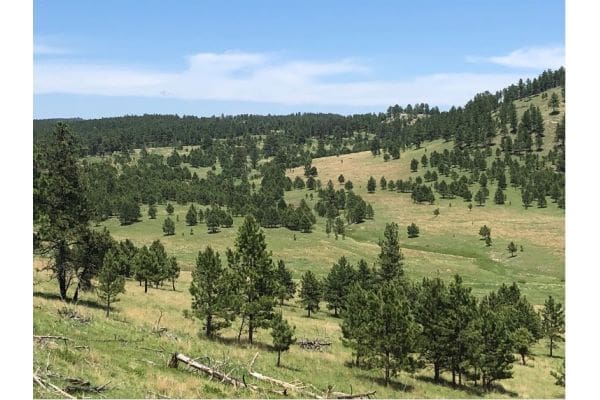Hunting and Fishing News & Blog Articles
Meadow Restoration in South Dakota’s Black Hills

EDGEFIELD, S.C.—A new 636-acre habitat enhancement project in the Black Hills of South Dakota is currently in progress, thanks to the collaborative efforts of the NWTF, the USDA Forest Service and the Rocky Mountain Elk Foundation.
Partners are working to bolster the area’s value for wildlife by removing encroaching trees, mainly small ponderosa pines and rocky mountain juniper. The end results will provide many benefits, including returning the area back to its historic vegetative structure, reducing the risk of uncharacteristic wildfire and making the landscape more productive for the critters that call it home.
The Black Hills National Forest encompasses 1.25 million acres in western South Dakota and extends into Wyoming. The area, considered sacred by Native American tribes, was named after the Lakota Sioux words “Paha Sapa,” meaning “hills that are black.”
The national forest is characterized by its predominate ponderosa pines, needle-like mountains and lowlands consisting of grasslands, where the NWTF and partners are working to enhance the native meadow habitats, important bugging areas for wild turkey poults.
Ponderosa pines nine inches in diameter or less and all sizes of Rocky Mountain Juniper are the primary targets for removal. Once the 636-acre parcel is selectively cleared, managers will conduct controlled burns to further reduce the risk of catastrophic wildfire and revitalize the meadow habitat.
“Ponderosa pine and Rocky Mountain Juniper establish at high densities and choke out other habitat types and reduce the overall value for wildlife,” said Clayton Lenk, NWTF district biologist for South Dakota, North Dakota, Wisconsin and Minnesota. “These management techniques are enhancing the grasses and forbs while increasing the health and vigor of the more mature and desirable trees within the meadow.”
While the project is expected to be ongoing throughout 2023, wild turkeys are already benefiting from the work.
“By removing the excessive conifers, it opens up the site to be filled with grasses and forbs that act as both a food source and cover for turkeys,” Lenk said. “The larger trees throughout the meadow will also provide roosting opportunities. This project benefits wild turkeys and is also great for other wildlife like elk and deer that would use these meadows as part of their wintering grounds.”
About the National Wild Turkey Federation
When the National Wild Turkey Federation was founded in 1973, there were about 1.3 million wild turkeys in North America. After decades of work, that number hit a historic high of almost 7 million turkeys. To succeed, the NWTF stood behind science-based conservation and hunters’ rights. Today, the NWTF is focused on the future of hunting and conservation through its Save the Habitat. Save the Hunt. initiative. Since 2012, this 10-year initiative has already eclipsed goals of conserving or enhancing more than 4 million acres of essential wildlife habitat, recruiting or retaining more than 1.5 million hunters and opening access to more than 500,000 acres for hunting and other recreation opportunities. This critical work will continue to impact wildlife habitat and our great outdoors in the final year of the initiative.
The post Meadow Restoration in South Dakota’s Black Hills appeared first on HuntingLife.com.
Copyright
© Hunting and Hunting Gear Reviews
